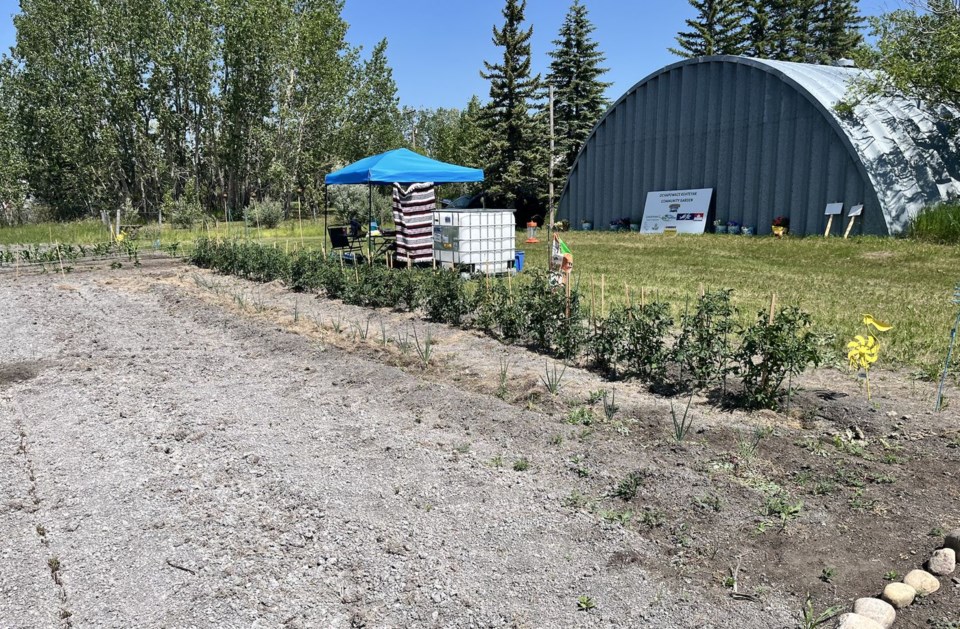PILOT BUTTE — Shortly after people gathered at the site of the Ochapowace urban community garden, something special happened.
“I think this land is blessed,” said Valerie Kinistino, Treaty 4 artist and community garden organizer from Ochapowace First Nation.
As everyone was gathered at the garden space a lightning bolt appeared to strike the earth.
“I believe it was a sign because no one was hurt by the lightning. It was so powerful,” she said. “This earth was charged.”
This spring, with the intent of promoting healthy eating and addressing food security, the Ochapowace First Nation started its own community garden, located near its Petro Canada station just east of Regina.
It's the first community garden Ochapowace has undertaken, and as such, required pure grit and determination
“We need to start growing our own food again, and teach this knowledge to our young people,” said Kinistino. “When we first tilled up that plot of land, it was all clay soil. It was a problem but that didn’t stop us.”
She estimates the ground hadn’t been tilled for over 100 years. So they recruited a few hardworking youth, employed some tillers, hauled in topsoil, and got to work. Eventually, the ground became workable and they planted tomatoes, corn, beans, onions, and potatoes.
“It shows that this land is giving,” said Kinistino. “The love and care of tending to this is going to yield so much more in the future. It’s going to grow bigger than all of us.”
Ochapowace plans to host a harvest ceremony, where youth, Elders, and members of surrounding communities will be invited to attend.
Kinistino hopes the garden will continue to grow so it could feed several First Nations other than Ochapowace.
She also sees it nourishing the youth.
“This is our future. I see so many people eating unhealthy,” said Kinistino. “So much sugar that leads to health issues. Some parents think we can’t afford to feed them anything but noodles, which lack nutrition.”
She hopes community garden projects like Ochapowace's will plant those seeds of change.
“We want young generations to understand the value (of gardens and healthy food) so their minds and bodies and spirits can grow,” said Kinistino.
Terry Lerat, councillor at Cowessess First Nation, and an advisor for the National Circle for Indigenous and Agriculture & Food (NCIAF) agrees because he's been a lifelong advocate for gardening, farming, and eating well.
“It’s always been my goal and personal mandate to bring food production and agriculture back to our First Nations,” said Lerat. “As communities in southern Saskatchewan, as our land was taken away from us we lost our ability to self-sustain on our own land.”
For decades, Lerat has worked in both livestock farming and agriculture production. He also founded 4C Farms on Cowessess in 2007, a community-driven initiative to cultivate agricultural roots through cattle ranching and farming. The operation has grown from 25 Angus cow-calf pairs to 260, and from 350 cultivated acres to 5,600.
Lerat, who helped out with the new Ochapowace community garden, said establishing this type of project in communities will yield more than just produce.
“The rewards of producing your own food are unrecognized until we start reintroducing it back into the communities – families feeding themselves on food they grew and produced,” said Lerat. “The win is a sense of pride as a family – taking care of their children with something they produced.”
To advance knowledge in food security, Lerat said Cowessess will host canning courses in urban centres and back in their Nation – a lost art which will help preserve healthy food and eliminate foods loaded with salt, sugars, and other preservatives, he said.
Lerat would like to see more greenhouses alongside schools, so young students can learn about producing food, which could be part of their own lunch programs.
“The younger we start these kids, the better it is for them to grow up with it, instead of working downwards with older generations,” he said. “Today, agriculture in the classroom consists of a styrofoam cup, a little bit of soil, and a bean. I don’t think that’s teaching them much.”
Lerat would like to see a garden at every single household on his First Nation. He believes it can be contagious with neighbours influencing each other to grow healthy food.
“Right now, a lot of parents aren’t gardening, but if we can get children interested, they might be the ones that drive the parents,” said Lerat.
“If you offer something fresh to kids, something they grew and have pride in, they’ll latch on to it and they’ll want more.”

.png;w=120;h=80;mode=crop)


